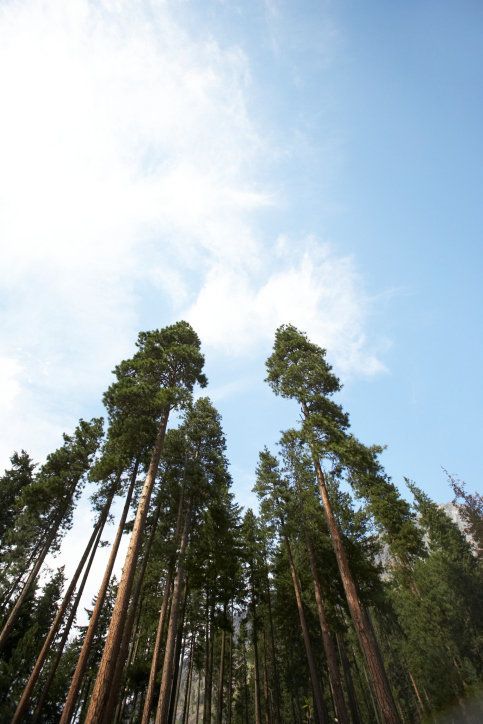
At the height of the blizzard that hit Washington, D.C. several months ago, two of my favorite trees--one a huge oak, and the other a dogwood--became bent from the weight of the snow, their branches frozen in place. Throwing on a coat, I ran outside into the blinding white. Freeing up the oak, I failed to rescue my dogwood. Drifts of snow as high as my waist buried its branches deeper. Despite further efforts, the tree uprooted.
Now, as spring blooms, I look out my window at the mound of fresh dirt where my charming dogwood friend once stood. I recall how, each year at this time, it appeared veiled in a cloud of petals. In particular, I loved the way it grew at a sharp angle, as if in defiance of its more upright neighbors. Eighteen years of living with such character and beauty: And it took losing it to appreciate it.
Losing such a familiar marker in my landscape made me think of other trees that have inhabited my life. On the Missouri farm where I grew up, a giant oak stood sentinel in my front yard, protectively brooding over my family. As a little girl, I'd dig in the dirt beneath its leafy shelter; growing older, I'd lean against its warm back, my dreams drifting upward. When times were troubled inside my house, that mighty tree was everything I wished my tempestuous, traveling, alcoholic father could be: a steady force who stood rooted in place, season after season.
Trees may be paragons of stability. But as the naturalist John Muir wrote, "The clearest way into the universe is through a forest wilderness." And indeed, it was through an encounter with trees that I first glimpsed a larger reality. When I was about ten years old, my family took a vacation to San Francisco. On a visit to the colossal redwoods, I ran off playing. Suddenly, I came upon my mother. She was standing transfixed amid shafts of light as they poured down through the trees. "What are you doing?" I asked, puzzled. "I was just about to hear the voice of God, and then..." she replied, pausing. For several pregnant moments, I waited with her, until the silence was broken by a group of passing tourists.
My mother, though she didn't know it, was tapping into an old and magical bond between humans and trees. At the Sanctuary of Dodona in ancient Greece, the rustling leaves of the oaks "spoke" to the priestess-oracles. The Buddha attained enlightenment while sitting beneath the shelter of a Bodhi tree. A lonely Jesus, abandoned by his disciples on the eve of his crucifixion, bowed his head among the olive trees in the Garden of Gethsemane. Among the Kwakiutl Indians of the Pacific Northwest, trees are considered sacred beings with souls and supernatural powers (The Power of Trees, by Michael Perlman).
In reflecting on why trees seem to speak to our innermost souls, I wonder if it stems from the great ages to which some species can live. My daughter-in-law Alison, a fire ecologist, has been studying core tree rings taken from Mountain Hemlocks at Crater Lake in Oregon. One sample, she tells me, dates back over five hundred years to 1462: just a youth, she says, compared to the oldest known tree, a Bristlecone Pine Tree nicknamed Methuselah in the White Mountains of California that dates back 4841 years. A tree that stood before Jesus, George Washington, the car, and the computer, I imagine, must be a veritable sage of wisdom.
My son Kabir, a microbial biologist, also tells me that the roots of trees are interlaced with fungal organisms in a mutually life-supporting system. His scientifically-based wonder at this subterranean civilization makes me think that if we are ever to find our way back to that golden age when nature and humankind co-existed in harmony, it might well be a tree that shows us the way. Gentle givers, they provide food and shelter to humans and creatures alike. Their roots bind the soil. Lungs of the earth, they breathe in toxic air and breathe out clean oxygen. Like nature's prophets, they stand as pillars of enduring wisdom and kindness in an ever-changing world. This noble alliance is one that we should strive to nurture.
A lifelong advocate of trees is Nobel Prize winner and environmental activist Wangari Maathai (Resurgence, Doubleday, September 2010, and Replenishing the Earth, Doubleday). Founder of the Green Belt Movement, which has planted over 30 million trees across Kenya, Maathai's passion for trees springs from her soul. Her idea of heaven, she told me in an interview, is "a beautiful forest, like the original Garden of Eden." Trees are wondrous beings to her because, she says, "even at night, when everyone else is asleep, they are awake. And as the branches dance in the wind, they are praising the Creator."
And so, this Earth Day, let us in turn praise those wise tribes of trees among whom we live. Long after we are gone---if we protect them---they will still be standing, memory-keepers of our time on the planet.